
Unreal Engine is one of the most popular and widely-used game engines in the industry, powering some of the biggest blockbuster games like Fortnite, NBA 2K, and Godot. But what makes this engine so special? How did it come to be? In this article, we’ll take a look at the brief history of Unreal Engine and explore its key features that make it such a popular choice among game developers.
Unreal Engine was first created by Epic Games in 1998 as a tool for developing interactive 3D content, including video games and virtual reality experiences. Its first iteration, known as Unreal Tournament, quickly gained popularity among gamers due to its smooth gameplay and realistic graphics, which were groundbreaking at the time.
In 2001, Epic released a new version of Unreal Engine called Unreal Engine 3, which introduced support for high-definition graphics and more advanced physics simulations. This version of the engine was used to develop a number of successful games, including Gears of War, which is still considered one of the best video games of all time.
In 2015, Epic released Unreal Engine 4, which introduced support for virtual reality development and greatly improved performance on mobile devices. This version of the engine was used to develop a number of successful VR games, including Beat Saber, which has become one of the most popular VR experiences to date.
One of the key features that sets Unreal Engine apart from other game engines is its use of Blueprints, a visual scripting system that allows developers to create complex game logic without having to write code. This makes it easier for developers to prototype and iterate on their games, as well as collaborate with others on the development process.
Another important feature of Unreal Engine is its support for real-time rendering, which allows developers to see how their game will look in real time as they create it. This can be especially helpful when working with large and complex environments, as it allows developers to quickly identify and fix any visual issues that arise.
Unreal Engine also offers a wide range of tools and features for developing interactive 3D content beyond games, including virtual reality experiences, augmented reality applications, and interactive installations. In fact, Epic has even used its own engine to create some of the most impressive VR experiences ever created, such as Fortnite’s live events and the Unreal Engine Showcase Demo, which features a number of stunning examples of what can be achieved with the engine.
Despite its many successes, Unreal Engine hasn’t been without its challenges. In 2019, Epic faced backlash from the gaming community after it was revealed that the company had been taking a cut of revenue generated by games built using the engine, including those created by other developers. This led to calls for greater transparency and control over revenue sharing in the gaming industry, as well as questions about the role of game engines in driving profits for their creators.
Despite these challenges, Unreal Engine remains one of the most popular and widely-used game engines in the world, with a community of millions of developers who are constantly pushing the boundaries of what is possible with the engine. Whether you’re a seasoned game developer or just starting out, there’s no denying that Unreal Engine is an incredibly powerful tool that can help you bring your creative vision to life.
In conclusion, Unreal Engine has come a long way since its inception in 1998, and it continues to be one of the most popular and widely-used game engines in the industry. Its unique features, such as Blueprints and real-time rendering, make it an attractive choice for developers looking to create complex and immersive games. While there have been challenges along the way, the community of developers using Unreal Engine remains committed to pushing the boundaries of what is possible with the engine.
